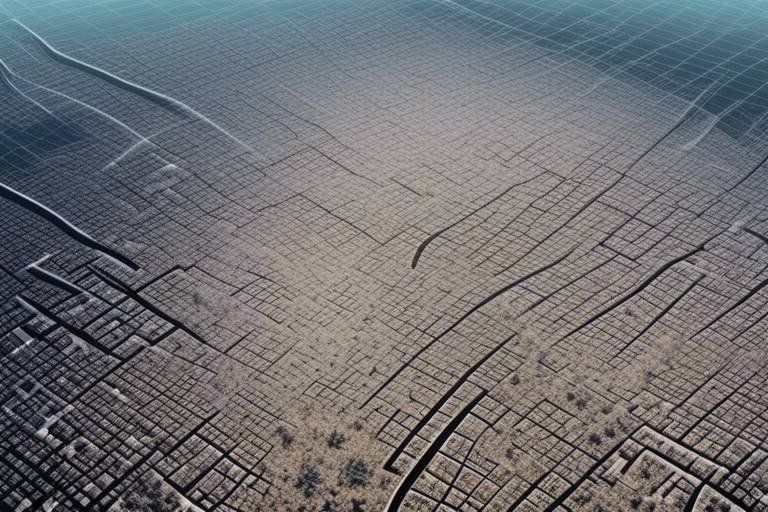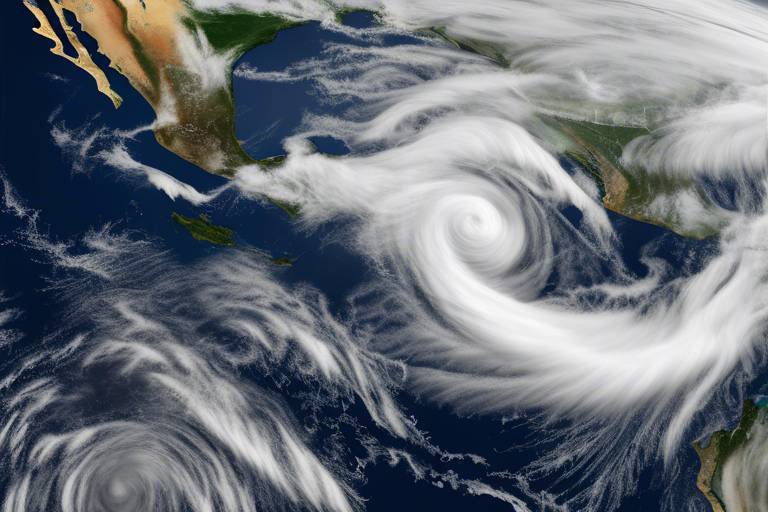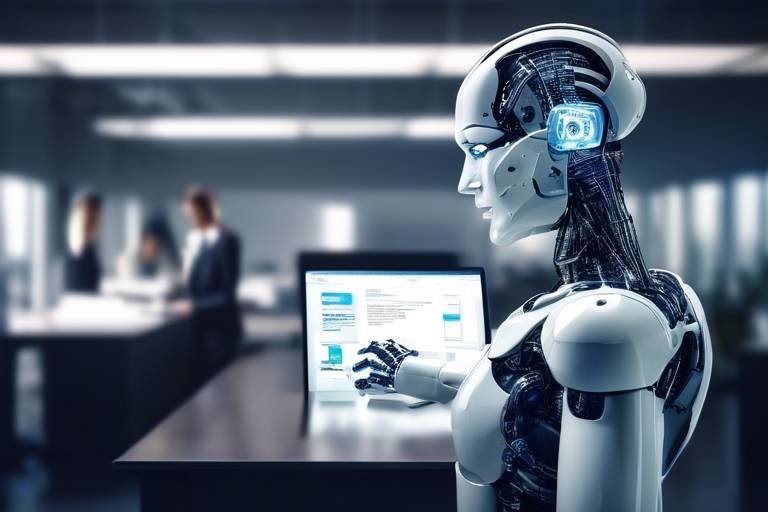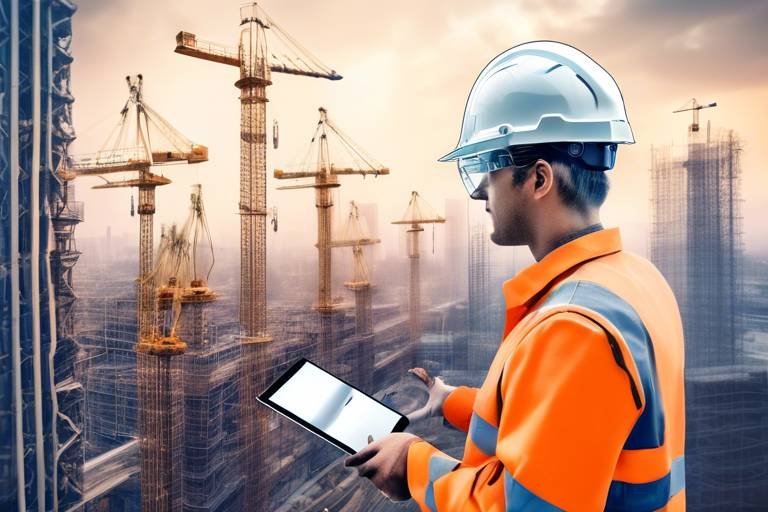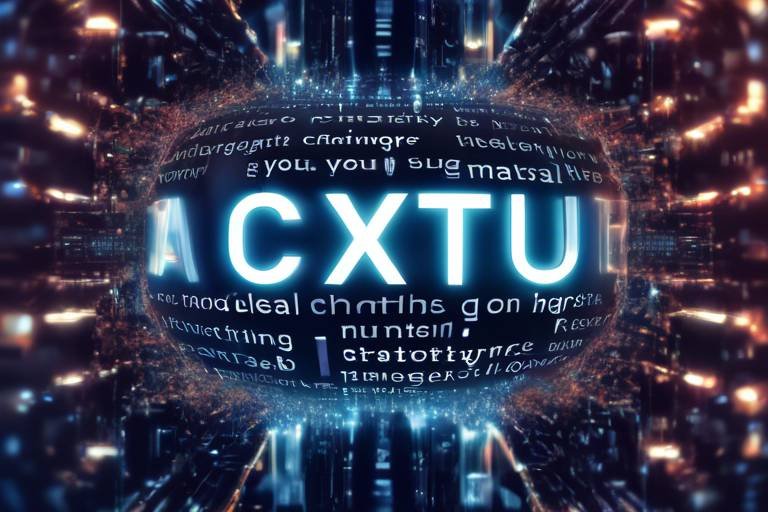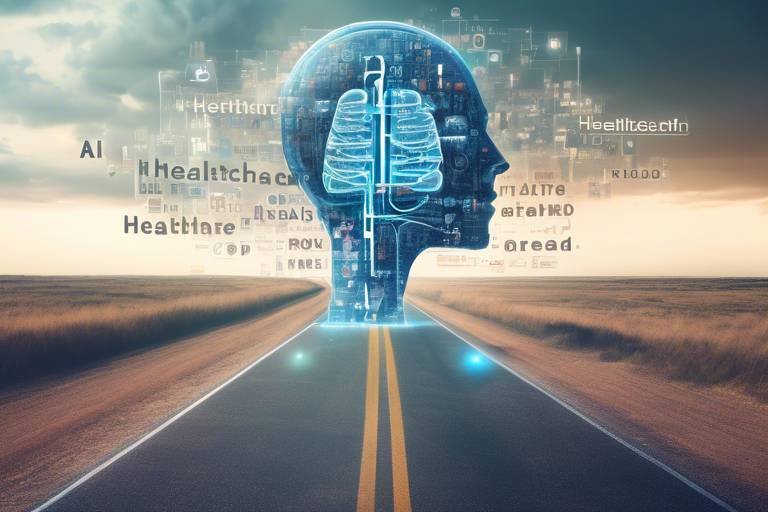AI Seismic Data Analysis: Revolutionizing Future Earthquake Predictions
In a world where natural disasters can strike without warning, the need for advanced predictive tools has never been more critical. Artificial Intelligence (AI) is stepping into the spotlight, transforming the landscape of seismic data analysis and offering a lifeline in the form of enhanced earthquake prediction capabilities. Imagine a future where we can anticipate seismic events with greater accuracy, significantly reducing the risk to life and property. This is not just a dream; it's becoming a reality as AI technologies evolve and integrate with traditional seismology.
Seismic data is generated at an astonishing rate, with millions of data points captured daily from various monitoring stations around the globe. The sheer volume of this data can be overwhelming, making it difficult for researchers to sift through and identify meaningful patterns. This is where AI shines. By leveraging machine learning algorithms, researchers can analyze vast datasets at lightning speed, pinpointing anomalies that may signal an impending earthquake. This ability to detect patterns that are invisible to the human eye is revolutionizing how we understand tectonic activities.
Consider the analogy of a skilled detective solving a complex case. Just as a detective uses clues to piece together a narrative, AI analyzes seismic signals to uncover the story behind potential earthquakes. This process not only improves prediction accuracy but also enhances our understanding of the underlying geological processes at play. The implications are profound: better predictions can lead to timely evacuations, improved infrastructure resilience, and ultimately, saved lives.
As we delve deeper into the role of AI in seismic data analysis, it's essential to highlight the innovative machine learning techniques that are being employed. From neural networks to decision trees, these algorithms are becoming indispensable tools in the seismologist's toolkit. They allow for the creation of predictive models that can forecast not just the occurrence of earthquakes but also their magnitudes and potential impacts.
One of the most exciting developments in this field is the application of deep learning models, particularly convolutional neural networks (CNNs). These models are adept at interpreting seismic waveforms, leading to more precise predictions. However, the effectiveness of these models is heavily reliant on the quality and quantity of training data. Comprehensive datasets that encompass a wide variety of seismic events are crucial for training these models effectively.
Yet, it's not all smooth sailing. Implementing deep learning in seismology comes with its own set of challenges. Data noise and variability in seismic signals can complicate the analysis, while the need for real-time processing capabilities adds another layer of complexity. Despite these hurdles, the integration of AI-driven methods with traditional seismological techniques is proving to be a game-changer. This hybrid approach allows for a more robust predictive framework, combining historical data with real-time observations to create a clearer picture of seismic risks.
To illustrate the real-world impact of these advancements, let's take a look at some notable case studies where AI has been successfully applied in seismic data analysis. Research projects across the globe have harnessed the power of AI to analyze seismic data, leading to breakthroughs in understanding earthquake patterns. These innovations have significantly improved early warning systems, providing communities with crucial information to prepare for potential seismic threats.
The future of AI in earthquake predictions is bright. With continuous advancements in technology and data analytics, we can expect even more sophisticated predictive models to emerge. As we stand on the brink of this new era, the potential for AI to enhance global safety measures is immense. By investing in these technologies and fostering collaboration between seismologists and data scientists, we can build a safer future for communities at risk of earthquakes.
- How does AI improve earthquake prediction? AI analyzes vast amounts of seismic data to identify patterns and anomalies that may indicate potential earthquakes, enhancing prediction accuracy.
- What are the challenges of using AI in seismic data analysis? Challenges include data noise, variability in seismic signals, and the need for real-time processing capabilities.
- What role do deep learning models play in seismology? Deep learning models, particularly convolutional neural networks, are effective in interpreting seismic waveforms, leading to more precise predictions.
- How can communities benefit from AI in earthquake predictions? AI can improve early warning systems, allowing communities to prepare and respond more effectively to potential seismic threats.

The Role of AI in Seismic Data Analysis
Artificial intelligence (AI) is not just a buzzword; it is a game changer in the realm of seismic data analysis. Traditionally, seismologists relied on manual interpretation of seismic data, which could be time-consuming and often prone to human error. However, with the advent of AI, we are witnessing a seismic shift—pun intended! AI algorithms can analyze vast datasets at lightning speed, uncovering patterns and anomalies that would take humans an eternity to identify. This capability is crucial because even the tiniest signals can be indicative of significant tectonic activity.
Imagine trying to find a needle in a haystack; that’s what traditional methods often felt like when predicting earthquakes. AI serves as a powerful magnet, drawing out those needles—potential earthquake signals—from the noisy haystack of seismic data. By utilizing advanced algorithms, AI systems can sift through years of historical data, learning from each tremor and quake. This leads to a more accurate prediction model that incorporates not just data from a single region but also global seismic activity.
One of the most exciting aspects of AI in seismic data analysis is its ability to adapt and improve over time. As more data becomes available, AI systems can refine their models, leading to increasingly precise predictions. This dynamic learning process is essential in a field where conditions can change rapidly. For instance, AI can help researchers identify microseismic events—small tremors that often precede larger earthquakes. By recognizing these patterns, scientists can issue warnings that could save lives and reduce damage.
Furthermore, the integration of AI with existing seismic monitoring systems enhances the overall effectiveness of earthquake prediction efforts. Traditional seismology provides a strong foundation of knowledge and data, while AI adds a layer of sophistication that enables real-time analysis. This combination allows for a comprehensive understanding of seismic activity, making it possible to assess risks and develop better preparedness strategies.
In summary, the role of AI in seismic data analysis is nothing short of revolutionary. It enhances the accuracy of earthquake predictions, improves our understanding of seismic phenomena, and ultimately contributes to saving lives and mitigating damage. With AI at the helm, the future of earthquake prediction looks brighter than ever.
- How does AI improve earthquake prediction? AI analyzes vast amounts of seismic data quickly, identifying patterns that may indicate potential earthquakes.
- What types of AI algorithms are used in seismic analysis? Machine learning techniques, particularly neural networks and decision trees, are commonly employed.
- Can AI predict earthquakes in real-time? Yes, AI can process data in real-time, allowing for timely predictions and warnings.
- What are the challenges of implementing AI in seismology? Challenges include data noise, variability in seismic signals, and the need for real-time processing capabilities.

Machine Learning Techniques for Earthquake Prediction
When it comes to predicting earthquakes, traditional methods often fall short due to the complex and chaotic nature of seismic activity. This is where machine learning steps in, offering innovative techniques that can analyze massive datasets and uncover hidden patterns. By leveraging algorithms that learn from historical data, researchers can significantly enhance their understanding of seismic events. Imagine trying to find a needle in a haystack; machine learning is like having a super-powered magnet that not only finds that needle but also tells you how many other needles might be hidden in the hay.
One of the most exciting aspects of machine learning in earthquake prediction is the use of neural networks. These algorithms mimic the way the human brain processes information, making them incredibly effective at recognizing complex patterns. For instance, a neural network can analyze thousands of seismic waveforms and identify subtle differences that might indicate an impending earthquake. The ability to process this data quickly allows scientists to react faster, potentially saving lives and minimizing damage.
Another technique gaining traction is the decision tree algorithm. This method breaks down data into a series of decisions based on certain criteria. Think of it like a flowchart that guides researchers through a maze of seismic data, helping them determine the likelihood of an earthquake based on various factors such as previous seismic activity, geological conditions, and even human activities like mining or drilling. The clarity this technique provides can be invaluable in making timely predictions.
Moreover, support vector machines (SVM) are also making waves in the field of earthquake prediction. SVMs work by finding the best boundary that separates different classes of data. In the context of seismic analysis, SVMs can help distinguish between normal seismic activity and signals that might indicate an earthquake. This separation is crucial for researchers as it helps them focus on the data that truly matters, enhancing the overall accuracy of predictions.
To fully harness the power of these machine learning techniques, researchers require vast amounts of quality data. This is where the integration of big data comes into play. Utilizing data from various sources such as seismic sensors, satellite imagery, and geological surveys, scientists can create comprehensive datasets that serve as the foundation for training machine learning models. The more diverse and extensive the data, the more reliable the predictions become.
However, it’s essential to recognize that while machine learning offers promising tools for earthquake prediction, it is not without its challenges. Issues such as data noise, which can obscure the signals of potential earthquakes, and the variability in seismic signals can complicate the accuracy of predictions. Additionally, the need for real-time processing capabilities means that researchers must develop systems that can quickly analyze incoming data and provide timely alerts.
In summary, the application of machine learning techniques in earthquake prediction is a game-changer. By utilizing advanced algorithms like neural networks, decision trees, and support vector machines, researchers are uncovering patterns that were previously hidden within the noise of seismic data. As technology continues to evolve, the potential for improving prediction accuracy and enhancing disaster preparedness becomes increasingly attainable.
- What is machine learning in the context of earthquake prediction?
Machine learning involves using algorithms to analyze large datasets and identify patterns that can indicate potential earthquakes. - How do neural networks contribute to earthquake prediction?
Neural networks can process complex seismic data and recognize subtle patterns that may indicate an impending earthquake. - What are some common machine learning techniques used in this field?
Common techniques include neural networks, decision trees, and support vector machines. - What challenges do researchers face when using machine learning for earthquake prediction?
Challenges include data noise, variability in seismic signals, and the need for real-time processing capabilities.

Deep Learning Models in Seismology
Deep learning models are truly revolutionizing the field of seismology, offering a sophisticated approach to interpreting seismic data. At the heart of this transformation are convolutional neural networks (CNNs), which excel at recognizing patterns in complex datasets. Imagine trying to find a needle in a haystack; this is akin to what seismologists face when analyzing seismic waveforms. However, with deep learning, these models can sift through vast amounts of seismic data, identifying subtle patterns that may indicate an impending earthquake.
One of the standout features of deep learning is its ability to learn from large datasets. The more data these models have, the better they become at making predictions. For instance, when trained on historical earthquake data, a deep learning model can recognize the telltale signs of seismic activity. This capability is akin to how a seasoned chef can discern flavors in a dish based on their extensive experience. The model essentially becomes a digital expert, capable of predicting the likelihood of future seismic events with remarkable accuracy.
However, the journey of implementing deep learning in seismology is not without its challenges. One major hurdle is the quality of the training data. If the dataset is riddled with noise or lacks diversity, the model's predictions can be significantly compromised. It’s like trying to teach a child to recognize animals using only pictures of cats; they may struggle to identify dogs or elephants. Therefore, having a comprehensive dataset that includes various types of seismic events is crucial for developing robust models.
Moreover, the real-time processing of seismic data is essential for timely predictions. In the world of earthquakes, every second counts. Implementing deep learning models requires advanced computational resources to ensure that predictions can be made as soon as new data comes in. This need for speed adds another layer of complexity to the integration of AI in seismology.
Despite these challenges, the potential of deep learning models in seismology is immense. By enhancing the accuracy of earthquake predictions, these models can play a vital role in disaster preparedness and response strategies. Communities can better brace themselves for seismic threats, ultimately saving lives and minimizing damage. As technology continues to advance, the fusion of deep learning and seismology promises to unlock new frontiers in understanding our planet's dynamic nature.
- What are deep learning models? Deep learning models are a subset of machine learning that use neural networks with many layers to analyze various types of data, including images and seismic signals.
- How do deep learning models improve earthquake predictions? These models analyze vast amounts of seismic data to identify patterns and anomalies, leading to more accurate predictions of potential earthquakes.
- What are convolutional neural networks? CNNs are a type of deep learning model particularly effective in processing structured grid data like images or seismic waveforms.
- What challenges do deep learning models face in seismology? Key challenges include data noise, variability in seismic signals, and the need for real-time processing capabilities.

Training Data Requirements
When it comes to the effectiveness of deep learning models in seismology, the quality and quantity of training data are paramount. Imagine trying to predict the weather without having access to historical data; it would be nearly impossible, right? The same principle applies to earthquake predictions. To develop accurate models, researchers must gather extensive datasets that encompass a variety of seismic events, ranging from minor tremors to major earthquakes. This variety ensures that the model can learn from different scenarios and recognize patterns that may indicate an impending quake.
Furthermore, the data must be meticulously labeled and organized. Each seismic event captured in the dataset should include details such as the magnitude, depth, location, and even the geological conditions at the time. This comprehensive approach allows the algorithms to understand the context of each event, enhancing their predictive capabilities. For instance, a dataset might include:
| Seismic Event | Magnitude | Depth (km) | Location | Geological Conditions |
|---|---|---|---|---|
| Event A | 5.2 | 10 | California | Fault line activity |
| Event B | 6.8 | 15 | Japan | Tectonic plate interaction |
| Event C | 4.5 | 8 | Chile | Subduction zone |
Moreover, it's crucial to address the data noise that often accompanies seismic recordings. This noise can stem from various sources, including human activities and natural phenomena unrelated to seismic events. To combat this, researchers employ data cleaning techniques to filter out irrelevant information, ensuring that only the most pertinent data is used for training the models. The cleaner and more relevant the data, the more reliable the predictions will be.
Lastly, the need for real-time data cannot be overstated. As seismic activities occur, having access to up-to-date information allows models to adapt and refine their predictions continuously. In a world where seconds can mean the difference between safety and disaster, the integration of real-time data into training datasets is not just beneficial; it is essential.
- What types of data are essential for training AI models in seismic analysis?
Essential data includes seismic waveforms, historical earthquake records, geological surveys, and environmental conditions during seismic events.
- How do researchers ensure the quality of seismic data?
Researchers implement data cleaning techniques, conduct regular audits of the datasets, and use multiple sources to cross-verify information.
- Why is real-time data important in earthquake prediction?
Real-time data allows models to adapt to new information, improving prediction accuracy and response times during seismic events.

Challenges in Model Implementation
Implementing deep learning models in seismology is not without its hurdles. One of the primary challenges is the presence of data noise. Seismic data can be incredibly complex and often contains a significant amount of background noise that can obscure meaningful signals. This noise can stem from various sources, such as environmental vibrations, human activities, or even the equipment used to collect the data. As a result, filtering out this noise while retaining the essential features of the seismic signals becomes a daunting task.
Another challenge is the variability in seismic signals. Earthquakes do not produce uniform signals; instead, they generate a wide range of waveforms depending on factors like the earthquake's depth, magnitude, and the geological characteristics of the region. This variability makes it difficult for machine learning models to generalize from one event to another, potentially leading to inaccurate predictions. To address this issue, researchers must develop models that can adapt to different types of seismic events while maintaining high accuracy.
Moreover, the need for real-time processing capabilities poses a significant challenge. In the realm of earthquake prediction, timing is everything. The ability to analyze seismic data and provide predictions in real-time is crucial for effective disaster response. However, many deep learning models require substantial computational resources and time to process data, which can hinder their applicability in urgent situations. This necessitates the development of more efficient algorithms that can deliver timely predictions without compromising accuracy.
Lastly, the availability of high-quality training data is essential for the success of deep learning models. Comprehensive datasets that encompass a wide variety of seismic events are crucial for training effective models. Unfortunately, such datasets are often limited, particularly in regions that are not frequently affected by earthquakes. This scarcity of data can lead to models that are not adequately trained, resulting in poor predictive performance. To overcome this, collaboration between researchers, governmental agencies, and organizations worldwide is essential to compile and share seismic data.
In summary, while the integration of AI and deep learning into seismic data analysis holds great promise, it is imperative to address these challenges. By focusing on reducing data noise, accommodating signal variability, enhancing real-time processing, and improving data availability, researchers can pave the way for more effective earthquake prediction models that ultimately save lives and mitigate damage.
- What is the main challenge in implementing AI for earthquake predictions?
Data noise and variability in seismic signals are significant challenges that can affect the accuracy of predictions. - How does real-time processing impact earthquake prediction?
Real-time processing is crucial for timely predictions, but many models require significant computational resources, which can delay results. - Why is high-quality training data important?
High-quality training data ensures that machine learning models are adequately trained, leading to improved prediction accuracy.

Integration with Traditional Seismology
Integrating artificial intelligence with traditional seismology is like mixing the old with the new, creating a powerful synergy that enhances earthquake prediction capabilities. Traditional seismology has long relied on established methods and historical data to interpret seismic activity. However, as the volume of seismic data grows exponentially, the need for more sophisticated analysis tools becomes apparent. This is where AI steps in, acting as a catalyst for innovation.
By combining the strengths of AI with traditional methods, researchers can develop a more comprehensive predictive framework. For instance, while traditional models often depend on statistical analysis of past earthquakes, AI algorithms can sift through vast datasets to identify complex patterns that may not be immediately apparent. This dual approach allows for a deeper understanding of seismic events, leading to more accurate predictions.
One of the most significant advantages of this integration is the ability to process real-time data alongside historical records. Traditional seismology can provide a solid foundation of knowledge, but AI can enhance this by constantly updating models with new information. Imagine a weather forecast that not only uses historical climate data but also incorporates live satellite feeds to predict storms. Similarly, AI can analyze current seismic activity and compare it with historical patterns to provide timely alerts about potential earthquakes.
Moreover, the integration fosters collaboration among scientists from various fields. Geologists, data scientists, and computer engineers can work together, sharing insights and methodologies. This interdisciplinary approach not only enriches the predictive models but also encourages innovation in data collection and analysis techniques.
However, it’s important to recognize that this integration is not without its challenges. Traditional seismological instruments and methods must be adapted to work seamlessly with AI technologies. For example, the data collected by traditional seismographs may need preprocessing to remove noise and enhance clarity before it can be effectively analyzed by AI algorithms. This requires careful calibration and validation to ensure that the insights derived from AI are trustworthy.
In summary, the integration of AI with traditional seismology represents a transformative shift in how we understand and predict earthquakes. By leveraging the strengths of both approaches, researchers can create more accurate models that not only improve prediction accuracy but also enhance our preparedness for seismic events. As technology continues to evolve, this collaborative framework will undoubtedly pave the way for groundbreaking advancements in earthquake science.
- What is the role of AI in earthquake predictions? AI helps analyze large datasets to identify patterns and anomalies that indicate potential earthquakes, improving prediction accuracy.
- How do machine learning techniques improve seismic data analysis? Techniques like neural networks and decision trees allow for innovative approaches in predicting earthquake occurrences and magnitudes.
- What challenges do AI models face in seismology? Challenges include data noise, variability in seismic signals, and the need for real-time processing capabilities.
- Can AI completely replace traditional seismology? No, AI complements traditional methods, enhancing their effectiveness and accuracy rather than replacing them.

Case Studies of Successful AI Applications
Artificial Intelligence (AI) is not just a buzzword; it's a transformative force reshaping how we understand and predict seismic activities. Numerous case studies showcase the successful application of AI in seismic data analysis, leading to remarkable advancements in earthquake prediction models. For instance, a groundbreaking project in California employed machine learning algorithms to analyze seismic data collected from various sensors across the state. The researchers utilized a vast dataset that included thousands of recorded seismic events to train their models. As a result, they achieved a significant increase in the accuracy of earthquake predictions, which is crucial for a state that frequently experiences tremors.
Another notable example comes from Japan, where AI technology was integrated into the country's already sophisticated earthquake monitoring systems. By employing deep learning techniques, researchers were able to enhance the speed and precision of their early warning systems. This integration allowed for real-time analysis of seismic waves, providing critical information that can be disseminated to the public within seconds of detecting an earthquake. The success of this project not only improved immediate response strategies but also fostered a culture of preparedness among the populace, significantly reducing panic during seismic events.
In the realm of research, several universities and institutions have launched initiatives to leverage AI for seismic analysis. For example, a collaborative effort between Stanford University and a tech startup focused on developing a predictive model using neural networks. Their research demonstrated how AI could identify patterns in historical earthquake data that were previously overlooked. The findings indicated that certain geological formations exhibited recurring seismic activity, which could serve as a warning sign for future earthquakes. This kind of insight is invaluable for urban planning and disaster management, ultimately saving lives and minimizing property damage.
The real-world impact of these AI applications extends beyond just predictions. Communities that have adopted AI-driven seismic analysis tools have reported enhanced resilience against earthquakes. For instance, in Chile, an AI-based system was developed to analyze real-time seismic data and provide immediate feedback to emergency services. This system enabled quicker mobilization of resources in the aftermath of an earthquake, ensuring that aid reached affected areas promptly. The combination of AI technology and community preparedness has proven to be a game-changer in disaster response strategies.
To summarize, the case studies of successful AI applications in seismic data analysis illustrate the profound impact that technology can have on our understanding of earthquakes. By harnessing the power of AI, researchers and communities are not only improving prediction models but also enhancing their overall disaster preparedness and response strategies. This synergy of technology and human effort represents a significant leap towards a safer future, where we can better anticipate and respond to the unpredictable nature of seismic events.

Notable Research Projects
In recent years, several have emerged, showcasing the incredible potential of AI in seismic data analysis. These projects have not only advanced our understanding of earthquake patterns but have also paved the way for innovative solutions aimed at enhancing public safety. One such project is the QuakeFinder initiative, which utilizes machine learning algorithms to analyze seismic data collected from various sensors. By identifying subtle changes in seismic waveforms, QuakeFinder has demonstrated the ability to predict earthquakes with a higher degree of accuracy than traditional methods.
Another groundbreaking project is the DeepSeis program, which employs deep learning techniques to interpret complex seismic signals. This initiative has shown promise in distinguishing between natural seismic events and those caused by human activity, such as mining or oil drilling. By developing a more nuanced understanding of these signals, researchers can provide better insights into potential earthquake risks in specific regions.
Furthermore, the Earthquake Early Warning System (EEWS) in California has integrated AI-driven models to enhance its predictive capabilities. This system analyzes real-time data from seismic sensors and employs machine learning to assess the likelihood of an earthquake occurring within a short time frame. The results from this project have been instrumental in improving emergency response protocols, allowing communities to prepare more effectively in the event of an earthquake.
These projects exemplify the transformative impact of AI in the field of seismology. By harnessing the power of advanced algorithms and vast datasets, researchers are not only improving prediction models but also enhancing our understanding of seismic behavior. The integration of AI into traditional seismological practices marks a significant step forward in the quest to mitigate the devastating effects of earthquakes on communities.
- What is AI in seismic data analysis? AI in seismic data analysis refers to the use of artificial intelligence techniques, such as machine learning and deep learning, to analyze vast amounts of seismic data for better earthquake prediction.
- How does machine learning improve earthquake predictions? Machine learning algorithms can identify patterns and anomalies in seismic data, enhancing the accuracy of predictions by analyzing historical data and real-time information.
- What are some challenges in implementing AI in seismology? Challenges include data noise, variability in seismic signals, and the need for real-time processing to ensure timely predictions.
- Can AI replace traditional seismology? No, AI is meant to complement traditional seismology techniques, providing a more robust analysis by integrating historical data with real-time observations.

Real-World Impact on Communities
The integration of artificial intelligence in seismic data analysis is not just a technological advancement; it is a lifeline for communities prone to earthquakes. Imagine a world where a potential earthquake could be predicted with a high degree of accuracy, allowing people to take necessary precautions. This is no longer a distant dream but a reality being shaped by AI. Cities like San Francisco and Tokyo, which have historically faced seismic challenges, are now leveraging AI-driven insights to enhance their disaster preparedness strategies.
For instance, AI systems can analyze historical seismic data alongside real-time monitoring to identify patterns that may go unnoticed by traditional methods. This capability allows local governments to issue timely alerts, enabling residents to evacuate or take cover. The impact of such technology can be profound; studies have shown that early warnings can reduce casualties by up to 50% in some scenarios. This means fewer lives lost and less devastation to property, which in turn accelerates recovery efforts.
Moreover, AI's role extends beyond just prediction. By analyzing the structural integrity of buildings and infrastructure in real time, AI can assist in determining which structures are at risk during seismic events. This information is invaluable for urban planners and engineers, as it guides them in reinforcing vulnerable structures and ensuring that new constructions adhere to the highest safety standards. In regions like California, where seismic activity is a constant threat, such proactive measures can save millions in repair costs and, more importantly, lives.
However, the real-world impact of AI in seismic analysis is not limited to urban areas. Rural communities also benefit significantly. For example, AI systems can help in creating community-specific emergency response plans tailored to the unique seismic risks of each area. These plans can include evacuation routes, emergency shelters, and communication strategies, ensuring that even the most remote populations are prepared for potential earthquakes.
To illustrate the effectiveness of AI in these scenarios, consider the following table that highlights key benefits:
| Benefit | Description |
|---|---|
| Improved Prediction Accuracy | AI algorithms analyze vast datasets, leading to more reliable earthquake forecasts. |
| Enhanced Emergency Response | Timely alerts allow communities to react swiftly, potentially saving lives. |
| Infrastructure Safety | Real-time monitoring helps assess and reinforce buildings against seismic threats. |
| Community Preparedness | Localized plans ensure that even rural areas are equipped to handle emergencies. |
In conclusion, the real-world impact of AI in seismic data analysis is profound and multifaceted. As technology continues to evolve, communities around the globe will increasingly rely on these innovations to safeguard their residents and infrastructure. The future is bright, and with AI leading the charge, we can look forward to a world where earthquake preparedness is not just reactive but proactive.
- How does AI improve earthquake prediction?
AI analyzes vast amounts of seismic data to identify patterns that may indicate upcoming earthquakes, enhancing prediction accuracy. - What role do machine learning algorithms play?
Machine learning algorithms, such as neural networks, are employed to analyze seismic data, offering innovative approaches to predicting earthquakes. - Can AI help in disaster response?
Yes, AI can provide timely alerts and create effective emergency response plans, significantly improving community preparedness. - What challenges does AI face in seismic analysis?
Challenges include data noise, variability in seismic signals, and the need for real-time processing capabilities.

The Future of AI in Earthquake Predictions
The future of AI in earthquake predictions is not just bright; it’s practically glowing with potential! As technology continues to evolve at a breakneck pace, the integration of artificial intelligence in seismic data analysis is set to revolutionize how we perceive and respond to earthquakes. Imagine a world where we can predict seismic events with incredible accuracy, giving communities the time they need to prepare and potentially save countless lives. Sounds like science fiction? Well, it’s becoming a reality!
Advancements in machine learning and deep learning are at the forefront of this transformation. With every new algorithm developed, we inch closer to a future where AI can analyze vast datasets in real-time, identifying patterns that human analysts might miss. This capability could lead to significant improvements in early warning systems, allowing alerts to be sent out seconds before an earthquake strikes. Think of it as having a weather forecast, but for seismic activity!
Furthermore, the continuous accumulation of seismic data from global monitoring stations will enhance the training of AI models. The more data these systems process, the better they become at recognizing the subtle signs that precede an earthquake. This means that future models will not only be faster but also more accurate. In fact, researchers are already working on algorithms that can predict not just whether an earthquake will occur, but also its magnitude and potential impact on specific regions.
However, it’s essential to acknowledge that the journey is not without its challenges. Issues such as data noise, variability in seismic signals, and the necessity for real-time processing capabilities need to be addressed. But with the pace of innovation in AI, solutions are being developed at an unprecedented rate. For instance, researchers are exploring ways to filter out noise from seismic data, allowing for clearer signals to be analyzed. This is akin to tuning a radio to get rid of static and hear your favorite song more clearly!
As we look ahead, collaboration between seismologists and AI experts will be crucial. By combining traditional seismological techniques with AI-driven insights, we can create a more comprehensive predictive framework. This synergy will not only bolster our understanding of seismic events but also enhance disaster preparedness and response strategies across the globe. Communities will be better equipped to handle the aftermath of earthquakes, leading to reduced damage and faster recovery times.
In conclusion, the future of AI in earthquake predictions is not just about technology; it’s about saving lives and safeguarding communities. As we continue to harness the power of AI, we can look forward to a world where earthquakes, while still unpredictable, can be managed with greater efficiency and effectiveness. The dream of precise earthquake predictions is on the horizon, and with it, the hope for a safer future.
- How does AI improve earthquake predictions? AI analyzes vast amounts of seismic data to identify patterns and anomalies that humans may overlook, leading to more accurate predictions.
- What are the main challenges in using AI for seismic analysis? Challenges include data noise, variability in seismic signals, and the need for real-time processing capabilities.
- Can AI predict the exact time of an earthquake? While AI can significantly improve prediction accuracy, predicting the exact time of an earthquake remains a complex challenge.
- What role does community preparedness play in earthquake response? Enhanced community preparedness can save lives and reduce damage by ensuring that people know how to respond when an earthquake occurs.
Frequently Asked Questions
- What is AI seismic data analysis?
AI seismic data analysis refers to the use of artificial intelligence technologies to process and interpret large sets of seismic data. By leveraging machine learning algorithms, researchers can identify patterns and anomalies that may indicate potential earthquakes, ultimately improving prediction accuracy.
- How does machine learning enhance earthquake predictions?
Machine learning enhances earthquake predictions by employing algorithms like neural networks and decision trees to analyze seismic data. These techniques allow for innovative approaches that can predict not only the occurrence of earthquakes but also their magnitudes, making predictions more reliable.
- What role do deep learning models play in seismology?
Deep learning models, particularly convolutional neural networks, play a crucial role in seismology by interpreting seismic waveforms. They provide a deeper understanding of seismic events, leading to more precise predictions and insights into tectonic activities.
- Why is training data important for deep learning models?
The effectiveness of deep learning models in predicting earthquakes heavily relies on the quality and quantity of training data. Comprehensive datasets that include various seismic events are essential for accurate model training, enabling the algorithms to learn and generalize effectively.
- What challenges do researchers face when implementing AI in seismology?
Researchers face several challenges when implementing AI in seismology, including data noise, variability in seismic signals, and the need for real-time processing capabilities. These factors can complicate the prediction process and require innovative solutions to overcome.
- How does AI integrate with traditional seismology?
AI integrates with traditional seismology by combining historical data analysis with real-time observations. This integration enhances the overall predictive framework, allowing for a more robust analysis that leverages both AI-driven methods and established seismological techniques.
- Can you provide examples of successful AI applications in seismic data analysis?
Yes! Several case studies showcase successful AI applications in seismic data analysis. These examples highlight improved prediction models that have significantly impacted disaster preparedness and response strategies in various regions.
- What is the real-world impact of AI on communities?
The implementation of AI in seismic analysis has a significant real-world impact on communities. It enhances resilience by improving preparedness and response strategies to potential seismic threats, ultimately saving lives and minimizing damage during earthquakes.
- What does the future hold for AI in earthquake predictions?
The future of AI in earthquake predictions looks promising! With continuous advancements in technology and data analytics, we can expect further improvements in prediction models, which will enhance global safety measures and better protect communities from seismic threats.

